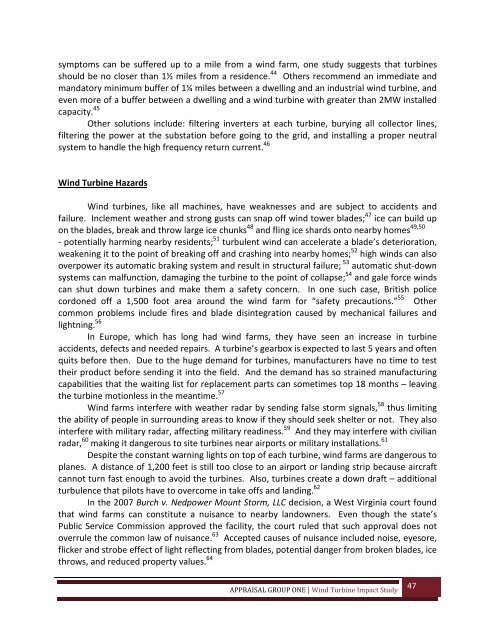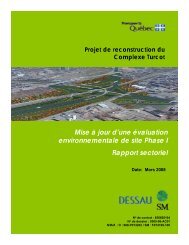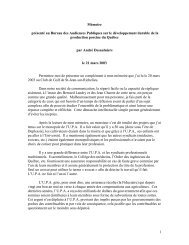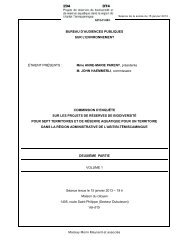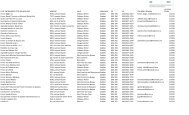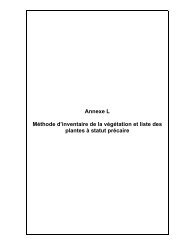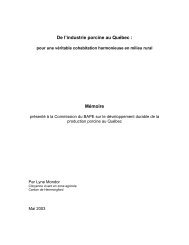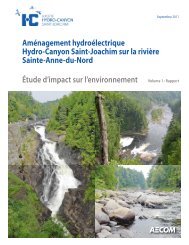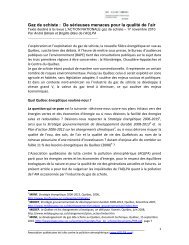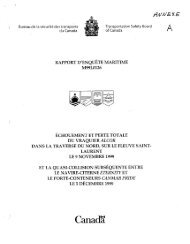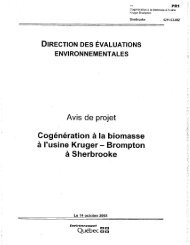WIND TURBINE IMPACT STUDY - BAPE
WIND TURBINE IMPACT STUDY - BAPE
WIND TURBINE IMPACT STUDY - BAPE
Create successful ePaper yourself
Turn your PDF publications into a flip-book with our unique Google optimized e-Paper software.
symptoms can be suffered up to a mile from a wind farm, one study suggests that turbines<br />
should be no closer than 1½ miles from a residence. 44 Others recommend an immediate and<br />
mandatory minimum buffer of 1¼ miles between a dwelling and an industrial wind turbine, and<br />
even more of a buffer between a dwelling and a wind turbine with greater than 2MW installed<br />
capacity. 45<br />
Other solutions include: filtering inverters at each turbine, burying all collector lines,<br />
filtering the power at the substation before going to the grid, and installing a proper neutral<br />
system to handle the high frequency return current. 46<br />
Wind Turbine Hazards<br />
Wind turbines, like all machines, have weaknesses and are subject to accidents and<br />
failure. Inclement weather and strong gusts can snap off wind tower blades; 47 ice can build up<br />
on the blades, break and throw large ice chunks 48 and fling ice shards onto nearby homes 49,50<br />
- potentially harming nearby residents; 51 turbulent wind can accelerate a blade’s deterioration,<br />
weakening it to the point of breaking off and crashing into nearby homes; 52 high winds can also<br />
overpower its automatic braking system and result in structural failure; 53 automatic shut-down<br />
systems can malfunction, damaging the turbine to the point of collapse; 54 and gale force winds<br />
can shut down turbines and make them a safety concern. In one such case, British police<br />
cordoned off a 1,500 foot area around the wind farm for “safety precautions.” 55 Other<br />
common problems include fires and blade disintegration caused by mechanical failures and<br />
lightning. 56<br />
In Europe, which has long had wind farms, they have seen an increase in turbine<br />
accidents, defects and needed repairs. A turbine’s gearbox is expected to last 5 years and often<br />
quits before then. Due to the huge demand for turbines, manufacturers have no time to test<br />
their product before sending it into the field. And the demand has so strained manufacturing<br />
capabilities that the waiting list for replacement parts can sometimes top 18 months – leaving<br />
the turbine motionless in the meantime. 57<br />
Wind farms interfere with weather radar by sending false storm signals, 58 thus limiting<br />
the ability of people in surrounding areas to know if they should seek shelter or not. They also<br />
interfere with military radar, affecting military readiness. 59 And they may interfere with civilian<br />
radar, 60 making it dangerous to site turbines near airports or military installations. 61<br />
Despite the constant warning lights on top of each turbine, wind farms are dangerous to<br />
planes. A distance of 1,200 feet is still too close to an airport or landing strip because aircraft<br />
cannot turn fast enough to avoid the turbines. Also, turbines create a down draft – additional<br />
turbulence that pilots have to overcome in take offs and landing. 62<br />
In the 2007 Burch v. Nedpower Mount Storm, LLC decision, a West Virginia court found<br />
that wind farms can constitute a nuisance to nearby landowners. Even though the state’s<br />
Public Service Commission approved the facility, the court ruled that such approval does not<br />
overrule the common law of nuisance. 63 Accepted causes of nuisance included noise, eyesore,<br />
flicker and strobe effect of light reflecting from blades, potential danger from broken blades, ice<br />
throws, and reduced property values. 64<br />
APPRAISAL GROUP ONE | Wind Turbine Impact Study 47


